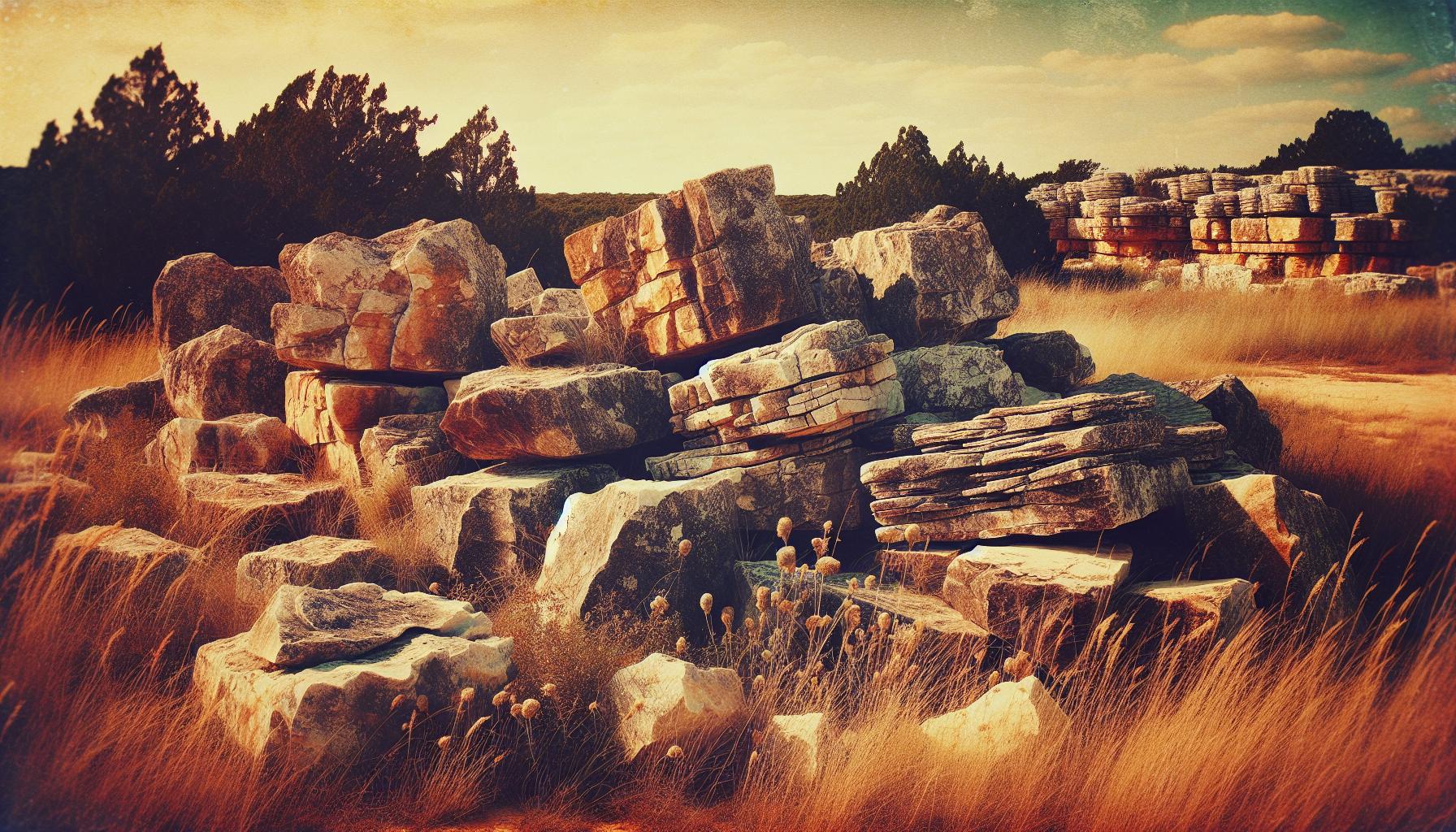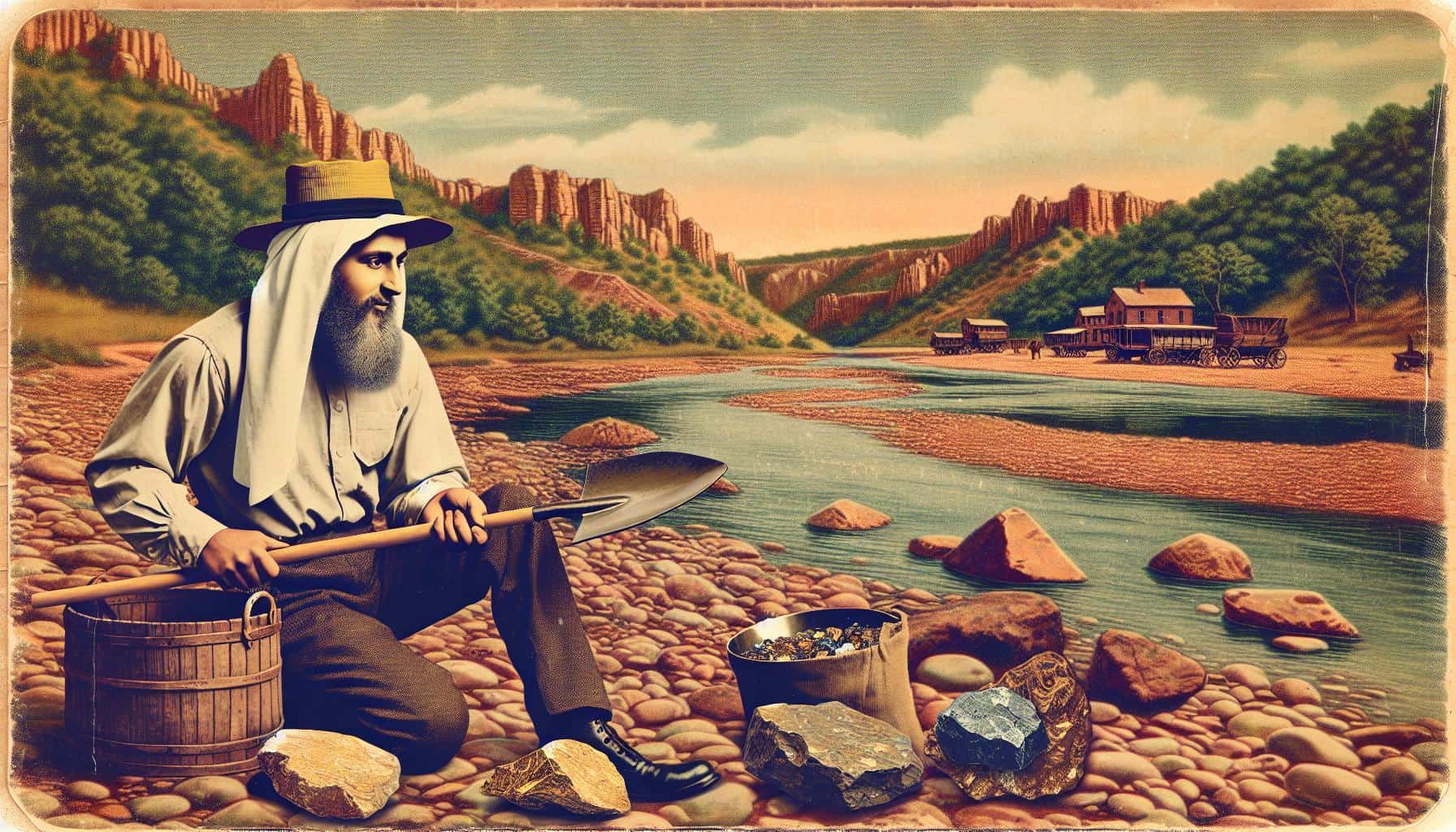Are you ready to uncover the hidden treasures beneath Oklahoma’s vast landscapes?
Rockhounding in the Sooner State offers an adventure that’s both educational and exhilarating. Whether you’re a seasoned collector or a curious beginner, you’ll find a variety of minerals, crystals, and fossils waiting to be discovered.
Oklahoma’s unique geology provides a rich playground for rock enthusiasts. From the Great Salt Plains to the Wichita Mountains, you’ll unearth treasures like barite roses, quartz crystals, and even ancient trilobites.
Get your gear ready and set out on a journey that promises to be as rewarding as it is fun.
Oklahoma offers diverse rockhounding opportunities, from selenite crystals at the Great Salt Plains to fossils in the Wichita Mountains. Key finds include quartz, barite roses, and ancient marine fossils. Ensure to respect local laws and land rights for a successful rockhounding adventure in the Sooner State.
Oklahoma Rockhounding Locations
Discovering the rich tapestry of Oklahoma’s geological wonders is an adventure that awaits you. The state is dotted with numerous locations for rockhounding, each offering its own unique set of treasures.
The Great Salt Plains, near Jet, Oklahoma, are renowned worldwide for their selenite crystal digs. Open to the public from April 1st to October 15th, you can unearth clear, hourglass-shaped selenite crystals, a fascinating result of the interaction between gypsum and saltwater. These crystals are not only exquisite but also carry the rare phenomenon of trapped sand inclusions, making them a must-have for your collection.
Venture to the Wichita Mountains to experience history frozen in time. Here you’ll likely spot beautifully detailed fossilized creatures from ancient epochs like trilobites and brachiopods. The region’s rugged landscape hides an exceptional variety of minerals and is accessible year-round.
For something truly unique, pay a visit to the Kee-Win Keebo fossil area. The history etched in these stones dates back over 300 million years, presenting both amateur and professional paleontologists with the chance to discover remnants of prehistoric marine life.
No rockhound’s journey in Oklahoma would be complete without exploring the varied terrains of the Arbuckle Mountains. This area is a hotspot for vibrant agate, calcite, and the state’s official mineral, rose rock. The latter, composed of barite, forms clusters resembling rose petals, a truly striking find.
Below is a quick reference for what you can find at each location:
| Location | Findable Treasures |
|---|---|
| Great Salt Plains | Selenite Crystals with Sand Inclusions |
| Wichita Mountains | Fossils (Trilobites, Brachiopods), Variety of Minerals |
| Kee-Win Keebo | Ancient Marine Fossils |
| Arbuckle Mountains | Agate, Calcite, Rose Rock (Barite Clusters) |
Each locale offers a different experience and potential for discovery, making Oklahoma a diverse playground for enthusiasts and seasoned rockhounds alike. Remember to research the specific rules and best practices for each rockhounding site to ensure a responsible and fruitful hunt.
What Gemstones are Found in Oklahoma?

When you’re venturing through Oklahoma on your rockhounding journey, you’ll find it’s not just a treasure trove of crystals and fossils. The state also harbors a variety of gemstones that are just waiting for you to uncover. Oklahoma’s diverse geology is fertile ground for precious finds.
Perhaps the most well-known gemstone in Oklahoma is the barite rose, commonly referred to as the ‘rose rock’. These unique formations most prevalent in the central part of the state are actually barite crystallized with sandstone, creating a rose-like appearance. The allure of these natural wonders is so compelling that the rose rock has been designated the official state rock.
Aside from rose rocks, Oklahoma is also a hidden gem for spotting a number of other precious stones:
- Garnets: These deep red gemstones are frequently discovered in the Red River area.
- Peridot: You might come across these green beauties within the confines of volcanic ash near the town of Spencer.
- Quartz: Varieties of quartz like the clear, smoky, and even the rare gold-infused citrine can be unearthed in the Wichita Mountains.
If you’re into specifics, the volcanic tuff found in the state is home to various microcrystalline varieties of quartz. So, your chances of stumbling upon jasper or agate are high—each patterned uniquely, ensuring that no two pieces you find are alike.
And let’s not forget that the Oklahoma state crystal, the hourglass selenite, can be found only in the Great Salt Plains. Its distinctive crystal formation, with an hourglass shape embedded within, is a result of the mineral-laden groundwater that permeates the area.
Your explorations may also lead you to find lesser-known but equally intriguing gemstones such as beryl, topaz, or even sapphires in varying hues. The chance of finding these stones may be lower, but the potential for a truly rare and exceptional find increases the excitement of the hunt.
What Sedimentary Rocks You Can Find in Oklahoma?

As you traverse the plains and hills of Oklahoma, you’ll discover that the state’s geological makeup is populated by an extensive range of sedimentary rocks. Limestone and sandstone are amongst the most prominent types you’re likely to encounter. These rocks are renowned for their paleontology potential, packed with ancient fossils that tell tales of prehistoric life in Oklahoma.
Limestone, in particular, often reveals marine fossils, a testament to the ancient seabeds that once covered the region. Red Fork sandstone is another formation to keep an eye out for. This distinctive sedimentary rock enriched with iron oxide not only paints the landscape with its reddish hue but is also an indicator of potential petroleum reservoirs beneath the surface.
Other sedimentary rocks found scattered across the state include shale, siltstone, and dolomite. Shale, for example, is frequently discovered in areas where fine particles have been consolidated over eons, and it often houses organic material that provides clues to the environmental conditions of the past.
- Limestone
- Sandstone
- Red Fork sandstone
- Shale
- Siltstone
- Dolomite
When you’re exploring the Washita and Arbuckle mountains, your rockhound instincts will be rewarded by the sight of massive boulders of conglomerate rock. These consist of smooth, rounded pebbles and other rock fragments that have been naturally cemented together. Their size and composition vary, making them intriguing additions to any collection.
The vast majority of these sedimentary treasures can be accessed through public lands or designated collecting sites. Always ensure you have the proper permissions and abide by local regulations when setting out on your rockhounding adventure. Remember, responsible collection practices not only protect Oklahoma’s rich geological heritage but also ensure that the beauty and wonder of rockhounding in the state is preserved for future generations.
What Metamorphic Rocks are found in Oklahoma?
Metamorphic rocks, transformed by intense heat and pressure, tell a story of Earth’s dynamic processes. In Oklahoma, these rocks aren’t as abundant as sedimentary types, but they offer unique insights into the region’s geological past. As you delve into the terrains of the Arbuckle Mountains, you’ll encounter some of the state’s most intriguing metamorphic formations.
Marble stands out among the metamorphic rocks you might discover. Originating from limestone subjected to metamorphism, marble in Oklahoma is primarily found in the Arbuckle Mountains. Its presence indicates a history of significant geological activity, which transformed the original carbonate rocks through heat and immense pressures. Another formation to look for is quartzite, a result of sandstone re-crystallization. This hard rock is evidence of extreme natural conditions that once prevailed in the area.
| Metamorphic Rock | Location in Oklahoma |
|---|---|
| Marble | Arbuckle Mountains |
| Quartzite | Various Locations |
The Wichitas, another geological marvel, harbor these ancient rocks. Schist and gneiss, featuring distinct foliated layers, are part of this assemblage. Each layer reflects a chapter of the Earth’s history, making them a fascinating find for rockhounds. Schist often contains flakes of mica which can shimmer in the sunlight, and gneiss, known for its banding, comes from even more intense metamorphic conditions than schist.
By exploring these areas, you’ll not only find these treasures but also piece together the geological puzzle of Oklahoma’s past. Always remember to seek permission before entering any private lands or designated rockhounding sites. And while it’s important to cherish these geological wonders, it’s equally crucial to preserve them. Practice responsible rockhounding by leaving no trace and taking only pictures, unless collecting is permitted.
You’re now equipped with the knowledge of what metamorphic rocks to look for and where they might be hidden. So grab your gear, respect the land, and embark on an adventure through Oklahoma’s geological tapestry.
What Igneous Rocks can You Find in Oklahoma?
In your search for geological treasures across Oklahoma, igneous rocks shouldn’t be overlooked. These rocks form from cooled magma or lava and offer a thrilling find for rockhounds. Oklahoma’s igneous rock varieties are as fascinating as they are diverse.
The Wichita Mountains are a prime spot for igneous rock enthusiasts. Here are some of the types you might come across:
- Granite, with its coarse-grained texture, is prominent in the Charons Garden Wilderness area.
- Rhyolite, a volcanic rock, can be discovered near Mount Sheridan.
- Pegmatite, known for containing rare minerals, is nestled within the Wichita’s rugged terrain.
Black Mesa, in the Panhandle, is another haven for igneous rock lovers. This region is renowned for its basalt formations. Derived from ancient lava flows, these rocks harbor a unique beauty and history.
When exploring for igneous rocks, it’s crucial to remember safety and legality. Ensure you’re rockhounding in areas open to the public and avoid trespassing on private lands without permission.
- Always wear safety gear, like gloves and goggles, to prevent injuries from sharp rocks.
- Familiarize yourself with each location’s rules and regulations before collecting.
- Obtain necessary permits if the area requires them for rockhounding.
Understanding the nature and origin of Oklahoma’s igneous rocks adds an extra layer of excitement to your rockhounding experience. Not only do you have the chance to hold a piece of the Earth’s fiery past, but you’re also contributing to the broader narrative of the region’s geological history.
Before setting out on your next adventure, brush up on identification techniques to distinguish between the various igneous rocks. Keeping a reference book or app handy can help you make accurate identifications of your finds.
Panning for Gold in Oklahoma
If you’re intrigued by the prospect of discovering gold, Oklahoma might just have a surprise for you. While it’s not widely known, Oklahoma rivers and streams do contain fine gold deposits. The process of extracting this gold, however, is less about striking a bonanza and more about enjoying the thrill of the hunt itself.
Panning for gold in Oklahoma rivers can be a rewarding recreational activity. You’ll most likely find success in areas around the Ouachita Mountains. Historically, this region was a component of the rich gold belt extending from Alabama to Canada. Waters such as the Arkansas River and other tributaries flowing out from the mountains often carry fine gold particles.
Before you set out, it’s vital to have the right equipment. You’ll need:
- A gold pan
- A sluice box (for more serious gold hunters)
- A metal detector (optional, but helpful in finding larger nuggets)
- A classifier (to sort through larger rocks)
Oklahoma’s rivers that have been known to contain gold include:
- The Arkansas River
- Cimarron River
- Canadian River
- South Canadian River
When panning for gold, you’re also likely to come across other interesting minerals and gemstones. Keep your eyes peeled for clear quartz, rose quartz, and even the occasional garnet which are often found in the same placer deposits.
Prospecting Laws and Regulations are critical to understand when searching for gold in Oklahoma. Ensure you’re not panning in a restricted area and respect private property boundaries. Engage with local prospecting clubs for insider tips and legal advice. Some areas may require a permit, so it’s worth checking with the Oklahoma Department of Mines or the U.S. Bureau of Land Management prior to your excursion.
Engaging in this hobby not only connects you with nature but could yield small bits of gold that energize your spirit of adventure. With a pan in hand, the rivers of Oklahoma are waiting for you to explore their hidden wealth.
Rocks and Minerals Found in Oklahoma
Oklahoma’s diverse geology yields a bounty of rocks and minerals that are a magnet for enthusiasts and collectors alike. When you’re out in the field, you’ll find barite, offering its bar-shaped crystal form to those patient enough to search. A stroll through the maze of Great Salt Plains brings you to selenite crystals, unique in their hourglass shapes embedded within.
The state’s historical volcanic activity gifts rockhounders with various igneous and metamorphic rocks. Marvel at granite boulders in the Wichita Mountains, revealing their speckled beauty. Attracted by rhyolite, you can explore ancient lava flows that have cooled into magnificent formations.
Below is a table of common rocks and minerals to keep an eye out for while exploring the Oklahoma terrain:
| Minerals | Locations | Notable Features |
|---|---|---|
| Barite | Arbuckle Mountains | Heavy, Crystal Formations |
| Selenite | Great Salt Plains | Hourglass Inclusions |
| Granite | Wichita Mountains | Speckled and Sturdy |
| Rhyolite | Wichita Mountains | Varied Textures |
| Rose Rock | Noble, Central OK | Barite Rose Formations |
| Quartz Crystals | Various Locations | Clear to Milky White |
Delving into the Turner Falls area, you’re likely to uncover rose rocks, the barite crystal clusters elegantly resembling rose petals. These treasures are so iconic that they’ve been designated as the official state rock.
Bear in mind that while you’re scouring the waterways, quartz crystals – ranging from transparent to a milky white – can often be found in Oklahoma’s alluvial deposits. Each quartz find adds a layer to your understanding of the natural history that has shaped these landscapes.
Tracing the paths of mineral-rich waters unveils a historical setting where lead, zinc, and even gold have settled, waiting beneath Oklahoma’s red earth. This intertwining of mineralization processes offers not just a treasure hunt, but a vivid chapter in the Earth’s geological storybook.
In pursuit of these geological wonders, always respect the environment and adhere to the guidelines for collecting. This responsibility ensures that rockhounding in Oklahoma remains a sustainable and rewarding adventure for years to come.
Where Can I Find Fossils in Oklahoma?
Oklahoma’s vast geology isn’t just rich with crystals and precious stones; it’s also a hotbed for fossil enthusiasts. If you’re on the hunt for a glimpse into the prehistoric past, you’re in luck. Across the state, there are numerous sites where you can uncover fossils that tell the story of ancient life.
In the Red Beds of western and central Oklahoma, you can find fossils dating back to the Permian Period. Here, fossils of marine creatures like trilobites and brachiopods are common. But prepare to get dirty; you’ll need to dig through layers of sediment to uncover these hidden treasures.
The Ozark Plateau region, particularly in northeastern Oklahoma, is fruitful for collecting. As you explore the limestone and shale formations, you might come across crinoid stems and other marine fossils. The area’s history as a shallow sea makes it a prime location for such findings.
Moving south, the Arbuckle Mountains are notable for their fossilized plants and ancient marine life remains. Limestone outcrops in this area hold evidence of a thriving ecosystem from millions of years ago. Visitors often report finding fossilized coral and sea creatures embedded in the rock.
For those interested in more recent history, the plains near the Great Salt Plains State Park offer a very different kind of quarry. Here, you might find ice age mammal fossils, such as mammoths and giant bison. While these big finds are rarer, the sense of adventure they spark is unmatched.
Remember to respect the rules of fossil collecting: significant finds should be reported, don’t trespass on private property, and always leave the sites as you found them. The thrill of discovering a piece of ancient history in Oklahoma’s varied landscapes is an experience in itself, where every unturned stone could lead to a remarkable discovery. Whether you’re a seasoned collector or new to rockhounding, uncovering Oklahoma’s buried past is sure to ignite your curiosity.
Oklahoma Rockhounding Laws & Regulations
When you’re eager to start your rockhounding adventure in Oklahoma, it’s crucial to be aware of the state’s laws and regulations. Prospecting and collecting on private land require explicit permission from the property owner. Without it, you’re trespassing and could face legal consequences.
In contrast, public lands often provide more freedom for rockhounders but come with their own set of guidelines. The Bureau of Land Management (BLM) and U.S. Forest Service manage these areas and typically allow for casual collecting without a permit. However, there are limits to the quantity and type of materials you can collect. The general rule is that if you’re collecting for personal, non-commercial purposes, you’re in the clear. Still, it’s best to check specific regulations for the area you plan to explore.
State Parks in Oklahoma have a no-collection policy to preserve their natural state for all visitors. If you find an irresistible specimen in one of these parks, you’ll need to admire it in its place. No exceptions.
Confidently planning your outing is key, and that means being in the know about the recent legislation. For instance, the American Lands Access Association (ALAA) is an excellent resource for staying up-to-date on rockhounding laws and gaining insight into pending or recent changes.
Remember, Oklahoma is known for its unique geological artifacts, but the integrity of these sites remains intact due to responsible rockhounding practices. Adhere to the guidelines, respect the land you’re exploring, and ensure that future generations can also enjoy the thrill of discovering Oklahoma’s natural treasures.
When in doubt, reach out to local rockhounding clubs or forums to share experiences and get advice on navigating the sometimes complex legal landscape. They can provide invaluable tips, like how to recognize claims or what kind of equipment might inadvertently put you in jeopardy of breaking the rules.
Rockhounding Tips for Beginners in Oklahoma
Gearing Up: Essential Tools for Rockhounding
Before setting out on your rockhounding adventure, you’ll need to gear up with some essential tools to make your expedition both productive and enjoyable. Starting with the basics, a sturdy pair of gloves is a must-have to protect your hands from sharp edges and rough surfaces. Additionally, a durable backpack will be indispensable for carrying your tools and treasures.
When it comes to the tools of the trade, there are a few key items that should be in every beginner’s toolkit:
- Rock hammer or geologist’s hammer for chiseling and splitting
- Chisels and pry bars to help extract specimens
- Safety goggles to shield your eyes from flying debris
- Field guide or identification book to help determine what you find
- Containers or bags to safely store your finds
Remember, investing in quality equipment can greatly enhance your rockhounding experience, ensuring you are well-prepared for a day of discovery.
Safety Tips While Rockhounding
Your safety should always come first when rockhounding in Oklahoma. Start by dressing appropriately for the conditions. Wear protective clothing including long sleeves, pants, and sturdy boots to shield against the elements and terrain. Remember the safety goggles you packed? Make sure they’re on anytime you’re chiseling or hammering.
Always let someone know your plans including where you’re headed and when you expect to return. This ensures that if anything unexpected happens, someone is aware and can call for help. Additionally, it’s wise to check the weather forecast before you leave and be prepared for sudden changes in weather conditions.
Stay hydrated by carrying plenty of water and use sunscreen as well as a hat to protect against the sun’s rays. Lastly, beware of local wildlife and have an awareness of the surrounding environment to avoid unexpected encounters.
Legal Guidelines for Rockhounding Enthusiasts
As you embrace the thrill of rockhounding, you must also be aware of the regulations that govern this activity. When on public land in Oklahoma, familiarize yourself with Bureau of Land Management (BLM) guidelines which generally allow for the collection of rocks and minerals for personal use. However, these collections have limitations to prevent commercial exploitation.
For rockhounding on private property, you’re required to obtain permission from the landowner beforehand. Trespassing can result in legal action, so always make sure your bases are covered in terms of consent.
Keep in mind that State Parks in Oklahoma maintain a no-collection policy, and removing any natural resources from these areas is prohibited. To avoid any legal complications, here are some steadfast rules to follow:
- Always ask for permission before collecting on private land
- Adhere to the collection limits and guidelines on public lands
- Avoid rockhounding in restricted areas such as State Parks and nature reserves
Embracing these practices ensures that you can enjoy rockhounding safely and legally, while preserving the natural beauty and geological integrity of Oklahoma’s landscape for future generations.
Conclusion: Oklahoma Rockhounding Guide
Embarking on your rockhounding adventure in Oklahoma is a journey filled with potential discoveries and the joy of unearthing nature’s hidden gems.
Remember to gear up with the right tools, respect the land, and always seek permission where needed. Staying informed about the latest regulations and connecting with local enthusiasts can greatly enhance your experience. Whether you’re panning for gold or seeking unique stones, you’re contributing to the rich tapestry of geological history. Keep the spirit of exploration alive while preserving Oklahoma’s natural beauty for everyone to enjoy.
Happy rockhounding!







